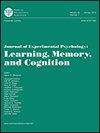不同类别的子集允许在混合搜索中灵活选择内存。
IF 2.2
2区 心理学
Q2 PSYCHOLOGY
Journal of Experimental Psychology-Learning Memory and Cognition
Pub Date : 2024-09-12
DOI:10.1037/xlm0001377
引用次数: 0
摘要
在许多日常情况下,我们会在视觉环境中搜索记忆中的许多记忆项目中的任何一个,这一过程被称为混合搜索。在某些情况下,记忆中的心理清单只有一部分与特定的视觉环境相关,因此,最好将记忆搜索限制在相关的子集上。以前的研究表明,参与者在逐次试验的基础上,基本上无法将记忆 "分割 "成几个不同的子集。然而,鉴于语义内容在长期记忆组织中的已知作用,我们假设,在动态混合搜索情况下,语义定义的子集类别可能会成为灵活选择记忆的更有力手段。实验 1 显示,语义特征(即对象类别)而非感知特征(如任意颜色)的确可以为灵活的记忆分区提供坚实的基础。实验2和3进一步表明,这种记忆分区是无成本的,而且与周围视觉干扰物的性质(即同类或异类显示)无关。这些研究结果表明,当不同的记忆子集由明确的语义类别定义时,将记忆搜索限制在当前相关的项目子集上是非常有效的。这些结果强调了概念信息在组织激活的长期记忆和形成灵活的逐次试验记忆选择基础方面的重要性。我们的研究结果进一步强调了视觉搜索与记忆搜索之间的关系,并可能揭示了在长时记忆中成功构建有界情节的过程。(PsycInfo Database Record (c) 2024 APA, 版权所有)。本文章由计算机程序翻译,如有差异,请以英文原文为准。
Categorically distinct subsets allow flexible memory selection in hybrid search.
In many everyday situations, we search our visual surroundings for any one of many memorized items held in memory, a process termed hybrid search. In some cases, only a portion of the memorized mental list is relevant within a specific visual context, thus, restricting memory search to the relevant subset would be desirable. Previous research had shown that participants largely fail to "partition" memory into several distinct subsets, on a trial-by-trial basis. However, given the known role of semantic content in long-term memory organization, we hypothesized that semantically defined subset categories might serve as a more powerful means for flexible memory selection in dynamic hybrid search situations. Experiment 1 revealed that, indeed, semantic characteristics (i.e., object category), but not perceptual features (e.g., arbitrary color), can provide a firm basis for flexible memory partitioning. Experiments 2 and 3 further showed that such memory partitioning is costless and is independent of the nature of the surrounding visual distractors (i.e., a categorically homogeneous or heterogeneous display). These findings demonstrate that confining one's memory search to a currently relevant subset of items is highly effective when the different memory subsets are defined by clear semantic categories. The results underscore the importance of conceptual information in the organization of activated long-term memory and in forming the basis for a flexible trial-by-trial memory selection. Our findings further highlight the relationship between visual search and memory search, and they may shed light on the processes contributing to a successful construction of bounded episodes in long-term memory. (PsycInfo Database Record (c) 2024 APA, all rights reserved).
求助全文
通过发布文献求助,成功后即可免费获取论文全文。
去求助
来源期刊
CiteScore
4.30
自引率
3.80%
发文量
163
审稿时长
4-8 weeks
期刊介绍:
The Journal of Experimental Psychology: Learning, Memory, and Cognition publishes studies on perception, control of action, perceptual aspects of language processing, and related cognitive processes.

 求助内容:
求助内容: 应助结果提醒方式:
应助结果提醒方式:


